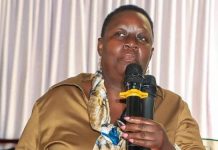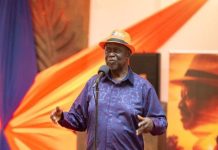By Faridah N Kulumba
Africa-Press – Kenya. On Monday 15th August 2022, all eyes were on Kenya to see who will be the fifth president after the hottest race between Deputy President William Ruto. and the opposition leader Raila Odinga who was endorsed by the incumbent President Uhuru Kenyatta. At the end of the day, Kenya’s Independent Electoral and Boundaries Commission (IEBC) announced DP Ruto as the president-elect amidst the scuffle among the IEBC members.
The results
According to the declaration of the results which was made by Mr. Wafula Chebukati IEBC Chairperson DP Ruto, 55 years of Kenya Kwanza won with 50.49 percent, followed by his strong competitor Raila 77 years of Azimio la Umoja with 48.85 percent in third place was George Wajackoyah, leader of Roots Party of Kenya with 0.44 percent, and David Waihiga Mwaure, leader of Agano Party with 0.23 percent.
Divisions among IEBC officials
A few hours before the declaration of the results chaos emerged when four out of seven IEBC commissioners including vice chairman Juliana Cherera disowned the results. During the press conference at Serena Hotel, they told journalists that they could not support the “opaque nature” of the final phase.
The majority of IEBC member’s grounds
According to the four commissioners the four presidential candidates’ results total that were announced by Mr. Chebukati exceeded 100 percent which cast doubt on the accuracy of the source of the figure tallied. When they demanded to verify their record they were denied access to the forms.
Besides that, they claimed that contrary to the Constitution and legislation, the results declared did not indicate the total number of registered voters, the total number of votes cast, or the number of rejected votes.
Will the law favors them
Article 138 of the Constitution says the Presidential vote shall be tallied and verified by the Commission and announced by the chairman. The constitution is given effects by Statutes, established law, tradition, and conventions. The parts relating to EEBC are effectuated by the IEBC Act and the Elections Act. that the IEBC chairman is Returning Officer was by Gazette Notice which cannot supplant the Constitution or Statutes.
Raila rejected the results
On 16th August presidential candidate Raila rejected the result declaration which was made by the IEBC chairman saying that the figures were null and void and must be quashed by the courts of law. He added that in their view, there’s neither a legally and valid declared winner nor a president-elect. He vowed to pursue all constitutional and legal options available to challenge the results.
Will history repeat itself or this is a new Kenya
Kenya’s elections have always been marred by irregularities. Kenya transitioned to a multiparty political system in 1991, after 26 years of single-party rule. President Moi five months before the end of his term dissolved parliament and ordered a fresh election in which the then ruling party Kenya African Nation Union (KANU), Forum for the Restoration of Democracy Kenya (FORD), and FORD Asili participated. The election was marked by large-scale intimidation of opponents and harassment of officials. This resulted in an economic crisis propagated by ethnic violence as Moi was accused of rigging electoral results to retain power.
Election violence traits- Elections have been along ethnic lines in many Kenyan communities and have been witnessed in several elections. Between 2007 and 2008, political violence, and economic and humanitarian crises erupted in Kenya after former President Kibaki was declared the winner of the presidential election held on December 27, 2007. These elections were fiercely disputed and triggered widespread violence throughout the country.
This was the most violent crisis that had hit Kenya since the Mau-Mau uprising. From the general election day and signing of the power-sharing agreement to 28 February 2008, Kenya was on the brink of civil war. In only two months, over a thousand people were killed and about 350,000 were forced to move around in search of refuge (Karabo, 2008). Subsequent reports point to almost 1,500 deaths and nearly 700,000 people internally displaced due to post-election violence.
Although there no much violence after the victory of the Jubilee Alliance in the March 2013 elections, with a tightly contested vote (with Jubilee avoiding a run-off by less than 1 percent) and yet again evidence of voting irregularities (Gettleman, 2013), the losing party and Kenyans turned to the courts instead of guns. However, it may not represent a trend nor the overcoming of the drivers of conflict but instead, a belief in the credibility (though fragile) of the institutions created or reformed under the new Constitution. However, many challenges still remain unresolved. And now all eyes are on Kenya to see what is going to happen after Raila rejected the results.
About President-elect Ruto
William Samoei Arap Ruto 55 years was born in Kenya in Sambut village, Kamagut, Uasin Gishu County on 21 December 1966. Ruto is currently serving as Deputy President of Kenya for 10 years since 2013. He became politically active 30 years ago.
It was not a surprise to Kenyans when Ruto showed interest in the top office when President Uhuru retired after his second term due to Kenya’s constitution, after all, he had declared publicly that he would vie for the presidency in the 2007 general elections. However, his statement was condemned by some Kenya African National Union (KANU) colleagues, including former president Daniel Arap Moi.
The ‘Hustler of the Nation’s early life
Ruto grew up in a poor family. Unlike other families in Kenya by the time, his father Daniel Cheruiyot, and mother Sarah Cheruiyot were struggling to make ends meet. The life Ruto grew up in forced him to do odd jobs at a tender age such as selling chicken and groundnuts along the streets of the Rift Valley in order to support his parents.
Ruto never wore shoes when he started schooling until when he was 15. That is why he described himself as the ‘Hustler of Nation’ in October 2021, vowing to defeat the ‘project of the system’ referring to Raila in the 9th August 2022 elections. Ruto has a Ph.D. from the University of Nairobi.
Political ambitions
Mentorship- Ruto’s ambitions for politics started while serving as the Chairman of the UoN choir when he met the then president Moi who introduced him to Kenya politics at later date, especially during the 1992 general elections. Ruto was part of the youth wing of President Moi’s once-dominant KANU party and was among the activists tasked with mobilizing voters for the country’s first multi-party elections held in the same year, under a youth group dubbed Youth for Kanu 92 (YK’92) from Kenya African National Union (ANU).
Presidential candidate- In 2012, President Uhuru and Ruto formed a coalition agreement with the ruling party Jubilee. They had an unwritten 20-year prenuptial agreement, in which Ruto would back Uhuru to serve as president for two terms. After that Uhuru would reciprocate by supporting his deputy to win the presidency in the 2022 election and he too would serve for two terms.
President Uhuru and Ruto’s relationship took a turn when Jubilee entered a pact with ODM opposition leader Raila On 19 March 2018, Uhuru and Raila shook hands in a symbolic gesture popularised as the “handshake,” which ended months of tensions following the disputed election in 2017 that gave Uhuru a second term. The agreement caused major rifts within the ruling party since it ushered in the Building Bridges Initiative (BBI).
In December 2020, Ruto announced his alliance with the newly formed United Democratic Alliance (UDA) party after President Uhuru started pushing for Raila as his successor. With God’s will and Kenyan votes if nothing changes Ruto will be sworn in on the 30th of this month.
For More News And Analysis About Kenya Follow Africa-Press






